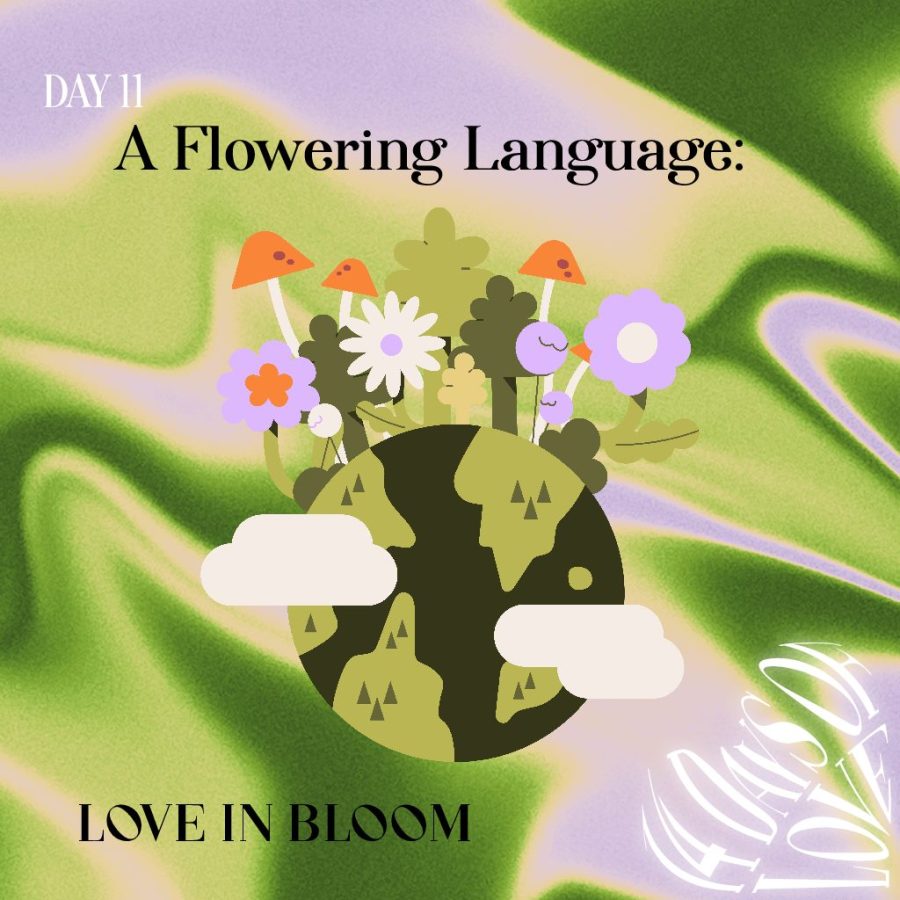14 Days of Love Day 11: A Flowering Language: Love in Bloom
February 11, 2023
Universally, flowers have become a gift-giving tradition used to express affection for loved ones. Every year, millions of people receive or gift flowers to commemorate various occasions, with an estimated 250 million flowers produced for Valentine’s Day alone. The act of giving or receiving flowers signifies fondness and intimacy, maintaining the thoughtful gesture throughout many eras and time periods. However, each flower contains a significant meaning, drawing back to the Victorian Era, when people would express emotion or give secret messages through an exchange of flowers.
The patriarchal society during the Victorian Era resulted in women and men having vastly different societal roles; men enjoyed various freedoms while women were limited to a secluded life with domestic activities. Women were assigned housewife skills, such as tending to the home and gardening, which resulted in the blossoming of a new language: floriography. Floriography is defined as the role of flowers as a means of communication. Taking pride in their work and femininity, Victorian women communicated through floriography, typically exchanging secrets or messages that could not be spoken aloud.
The initial rise in the popularity of flowers is accredited to Lady Mary Wortley Montagu, wife of a British ambassador to Turkey. In her letters sent back to England, she wrote of a Turkish tradition where floral symbols and objects were assigned meanings to convey a secret love message. Published in 1763, Montagu’s letters became the catalyst for the romanticization of flowers. Following Lady Montagu’s letters, floriography dictionaries were published, such as Charlotte de Latour’s “Langage des fleurs.” Flower-giving became widespread in Victorian society, with each flower and the way one handed it to the recipient possessing a unique meaning.
The way in which a flower was handed to the receiver or the condition of the flower determined the secretive message. When a flower was given to someone upside down, it meant the opposite of what the flowers symbolized. If a flower was offered with the right hand, it meant “yes,” while a flower given with the left hand meant “no.” Though some had different interpretations of what a flower meant, roses have always maintained their iconic representation of love.
Within literature, the love language of flowers is very prevalent, especially in the works of ancient Greek mythology and William Shakespeare. Roses, for example, stem from the myth of Aphrodite — the goddess of love and beauty — and the tears she cried over her lover, Adonis; she cried a mixture of rose petals and blood, producing a beautiful rose bush. Classic myths like these inspired the decorated playwright, Shakespeare, to include the use of flowers as a metaphorical means of love and tragedy. In Shakespeare’s “Venus and Adonis,” Shakespeare alludes to the use of roses as an epithet to the character of Adonis in the play’s opening lines: “Rose-cheeked Adonis.” Shakespeare incorporates the Victorian love language of flowers into various of his plays, such as the tragedies of “Romeo and Juliet” and “Hamlet.” “Romeo and Juliet” uses flowers as a descriptor of budding romances and beauty. “Hamlet” is especially prevalent in its use of flowers to convey love; in “Hamlet,” the character Ophelia is driven by her tragic love for Hamlet, having used flowers to communicate messages with her unrequited lover.
Flowers and floriography are omni-cultural, transcending all languages and barriers. Throughout literature, history, nature and human relations, flowers remain impactful. Today, flowers are a common gift, whether it be to a romantic partner or a loved one. Here are some flowers you can give for certain occasions, platonic or romantic.
Roses
Starting off with the most classic and popular flower, roses are notably associated with love. Specifically, red roses have become intertwined with the idea of lovers. White roses symbolize purity and innocence, pink roses mean admiration, yellow flowers represent friendship and the rare purple rose is characterized by majesty — a perfect gift for somebody you may admire or look up to.
Tulips
Tulips may serve as the perfect way of declaring your deep, unconditional love for someone, being associated with romance and perfect love. Give a red tulip to somebody you want to declare your passionate, undying love to. However, suppose you are not feeling as intense with your declaration. In that case, pink tulips symbolize love, affection and care — the perfect gift for either a romantic partner, a friend or family member.
Peonies
Peonies signify lasting love, prosperity, good luck and honor. Similar to tulips and roses, red peonies are a sign of love, passion and respect — the perfect gift for a romantic partner. Pink peonies symbolize good luck and prosperity and are often interlinked with marriage.
Chrysanthemums
Chrysanthemums hold different meanings in a diverse number of cultures, adding to their uniqueness. In the United States, Chrysanthemums symbolize friendship, happiness and devoted love. In Asia, Chrysanthemums are representative of life and rebirth. They are a great way of displaying one’s eternal love, and are a great flower to give to family. Orange and yellow chrysanthemums signify happiness and good feelings, while pink chrysanthemums symbolize friendship, affection and platonic love — the perfect gift for a best friend.
Carnation
There is a reason carnations are a prominent flower on Valentine’s Day, and similar to the flowers listed above, each flower’s meaning is dependent upon its color. Deep red carnations symbolize love, affection and captivation, serving as the closest alternative to red roses. On the other hand, light/pale red carnations symbolize admiration and adoration, signifying the notion of “my heart aches for you.” Pink carnations symbolize gratitude and appreciation and are a great floral gift for showing appreciation to your friends and family.









